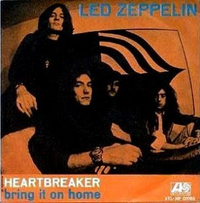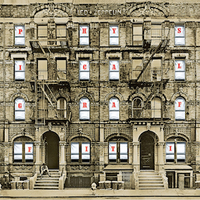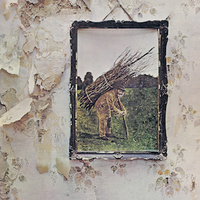30. Communication Breakdown (Led Zeppelin, 1969)
Recorded in September 1968 and originally released in the US as the flip-side to debut single Good Times Bad Times, Communication Breakdown is now recognised as one of rock’s pivotal primal screams – a sonic stepping stone to both punk (The Ramones and The Damned were fans) and heavy metal. Yet while Breakdown has its roots in antiquity – it was inspired by Eddie Cochrane’s 1957 hit Nervous Breakdown – it also holds up a (shattered) mirror to the turbulent times, Page’s lacerating guitar and Plant’s lupine howl as incendiary as the student riots sweeping Europe in protest at the Vietnam War.
29. Hey, Hey, What Can I Do (single b-side, 1970)

Though undoubtedly leveraged into its high standing due to its relative unavailability – B-side to Immigrant Song in 1970, not reappearing until 1990’s box set – there’s something awe inspiring about a band who can afford to side-line such obvious riches. John Paul Jones adds acoustic guitar to his Zeppelin CV, his mandolin and bass already driving the track, and Plant’s woman woes take centre stage, again.
28. The Ocean (Houses Of The Holy, 1973)
The final track on Houses Of The Holy. Although this record is viewed by some critics as the band’s least satisfactory mid-term work, it yielded The Song Remains The Same, as well as The Ocean. This tune is a heavy blues rock anthem, which features Jimmy Page’s typical, no-nonsense minor pentatonic riffing that has inspired several generations (it was even sampled to great effect on the Beastie Boys’ first album, Licensed To Ill). The song kicks off with John Bonham audibly counting in the beat and uttering the immortal line 'We’ve done four already, but now we’re steady, and then they went 1, 2, 3, 4…' The drum attack is particularly savage on this track, and the guitars cut through it all with a vibrancy that was years ahead of its time. It was partly recorded at Electric Lady Studios in New York and the rest was done at Olympic in London. Although the edits aren’t obvious, there’s a distinction between the two sections. The first part is uptight and funky, then The Ocean unexpectedly moves to a swinging sequence, with Bonham switching to a big-band style that fills behind Page’s superb jazz solo. Robert’s lyrics are matched by rare backing-vocals from the rhythm section. Plant finally explained the song is dedicated to his then three-year-old daughter, Carmen.
27. Heartbreaker (Led Zeppelin II, 1969)

Although the latter part of Led Zeppelin II was somewhat uneven, Heartbreaker was among the highlights. The fifth track was recorded and mixed at the A&R studios in New York and showcased one of Page’s most exciting and memorable guitar outbursts. Robert’s question – 'Hey fellows, have you heard the news?' – sets up a dynamic groove, which the band supports. The band even stops dead in its tracks to allow Page to explode all over his fretboard, before drums and bass clamber back. The guitar picks up speed as Page piles climax upon climax. After an abrupt halt, Plant returns to continue his diatribe: 'You abused my love a thousand times!' The song became one of the favourites for the band to perform live from October 1969 onwards, and was used as a set opener, alternating with Immigrant Song. Jimmy would extemporise at length during his Heartbreaker solo, often quoting from Greensleeves or from themes by Bach.
26. The Rover (Physical Graffiti, 1975)

Page can do bombastic, he can do blues, he can do 50’s rock’n’roll and he can definitely do guitar melody as well as anyone. The solo on this underrated gem is ample proof. The Rover was originally worked on during the Zep III sessions, but eventually issued on subsequent Zep album Physical Graffiti instead.
25. How Many More Times (Led Zeppelin, 1969)

It may owe substantial debts to both Albert King’s The Hunter and Howlin’ Wolf’s How Many More Years, but this nightmarish eight-and-a-half-minute closer to Zep’s debut album has a dark heart all of its own. Opening with a stinging burst of wah-wah guitar, Plant’s carnivorous vocal ('I was a young man, I couldn’t resist') and Page’s eerie bowed guitar – a nod to his days in The Yardbirds – combine to establish the maleficent mood before the song develops into a molten rolling blues, as chilling as it is awe-inspiring.
24. Fool In The Rain (In Through The Out Door, 1979)

The Caribbean feel of Fool In The Rain is initially reminiscent of D’yer Mak’er played backwards. For a moment guitar and keyboards link up to follow the stumbling-but-progressive riff in tandem, and the results are… charming. But should we be using the word ‘charming’ in relation to Zeppelin? Probably not. There’s a high-pitched whistle after about three minutes, and a salsa beat kicks in. Plant’s refrain ‘Light of the love that I’ve found’ lodges in your brain. An outstanding Bonham showcase from Zeppelin’s studio swansong, Fool In The Rain highlights the fusion influence of such jazz giants as Bernard Purdie and Alphonse Mouzon. Clock the percussive perfection at two minute 25 seconds when a blow of a whistle ushers in a Latin samba delight.
23. The Song Remains The Same (Houses Of The Holy, 1973)

Upon release in 1973, this track was just the latest in a string of classic Zeppelin album openers. Prior to album sessions, this song was rehearsed with the working title Worcester And Plumpton Races – a reference to Page and Plant’s respective homes. When they worked on it in the studio, that title was changed to first The Overture and then The Campaign. It was only when Plant started scribbling verses for it that it ceased to be an instrumental and became his paean to the music of the world, whatever form it takes. “The whole album had a very upbeat quality to it,” producer Eddie Kramer told Classic Rock. “You can hear that straight away from this opening track. A much brighter sound than on earlier Zeppelin albums. There was a unity of spirit and a unity of direction of sound. A lot of that had to do with Pagey and the fact he had a very clear idea of what he wanted. I believe Jimmy later had Robert’s vocals speeded up a bit so that they become another layer to all those gorgeous guitars.
22. The Battle Of Evermore (Led Zeppelin IV, 1971)

Based on a tune written late one night at Headley Grange by Page while messing around on Jones’ mandolin, Battle Of Evermore’s improbable blend of mythical allusion and Scottish folklore achieves an otherworldly grace thanks to Plant’s Arthurian lyric ('I’m waiting for the angels of Avalon / waiting for the eastern glow') and Sandy Denny’s ethereal vocal – impressive enough for the band to award her her own symbol on the album’s sleeve. None of which explain’s Evermore’s unique allure, a masterpiece of musical storytelling where you can almost hear 'the horses thunder, down in the valley below'.
21. All My Love (In Through The Out Door, 1979)

All My Love is plain beautiful. With Page notably absent from the songwriting credits, Plant offers a paean to his deceased son in a song steeped in fond remembrance. But you can’t help but giggle at the way Bonzo tries to heavy it up about halfway through. Page takes a noodling role, but unlike some of his other more meandering interludes, this time it’s somehow to the benefit of the track, not its detriment. Plant is on top form as he whispers the emotionally-charged words: ‘All of my love… to you now.’
Classic Rock Newsletter
Sign up below to get the latest from Classic Rock, plus exclusive special offers, direct to your inbox!